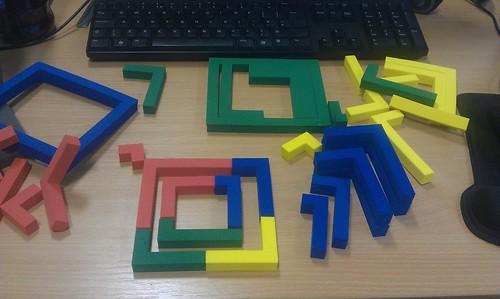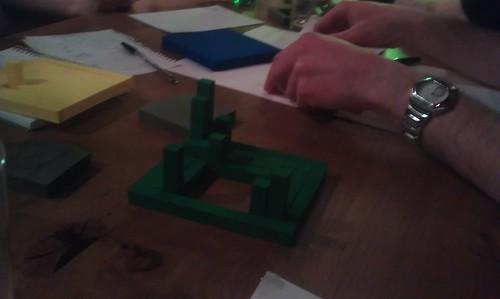Newcastle MathsJam January 2012 Recap
January’s MathsJam was a bit massive. It’s now a week later and I’ve only just gathered enough thoughts together to do this writeup.
There were nine of us this month, all but one of whom either maths students or lecturers. A major theme of the night was of professional mathematicians or nearly-professional mathematicians forgetting basic high-school methods. This led to quite an intense session of puzzling and proving.
Things didn’t start out that way, though. A few weeks ago I found the website of a mathematician in Illinois called Alan Schoen, and his page about Lominoes. They’re a pretty interesting set of shapes! I ordered a couple of sets and they arrived just in time for the MathsJam.
We spent a lot of time trying to build a ziggurat:
Because I had two sets, we split into two teams and the competition got a bit serious. The spirit of friendly cooperation was away on a business trip.
Team A (best team, my team) did a lot of writing and calculations and thinking. We hardly touched a piece other than to measure it.
Team B, on the other hand, were much more hands-on in their deliberations. They got quite emotionally involved with the pieces – when I asked why a particular pile of pieces wasn’t being touched, I was informed that those were the “bad” pieces.
A key point of contention was the question of which pieces needed to be used. I think we settled on everything except the greys and half the blues.
We spent well over an hour trying to build a ziggurat. Neither team succeeded: both teams failed. While packing the pieces away, Andrew (Team B, free spirit) constructed this challenging artwork:
Matthew Taylor again posted a puzzle on Twitter before the MathsJam night. This time it was a question about points with integer coordinates on the boundary simplex-ish shapes. We didn’t find a solution.
A Fibonacci fact
David Cushing showed me this fact. It’s pretty cool!
Draw an
Pick any
What’s the pattern?
The others at MathsJam spotted what was going on with a little bit of prompting. Click here if you’d like a spoiler.
The Dorset MathsJam posted a problem to twitter:
DOR: 4 cups upside down. Turn over 3 at a time. Minimum number of moves to turn all right way up?
— Maths Jam (@MathsJam) January 24, 2012
This is pretty similar to the lights-out puzzle we discussed in December. It turns out that Stephen, one of the new attendees this month, had a much better proof that not all patterns in the lights-out puzzle could be produced: all of the moves change either zero or two corner squares, so patterns with an odd number of corners lit up can’t be produced.
A bug on a boinger
Andrew posed this conundrum:
I have a
After you’ve had a think, click here for the answer.
Emboldened by his solution to the last puzzle, Ji posed this question
Silly people chasing each other
There are
Working out what happens shouldn’t take too long. Working out when it happens involves a bit of geometry. If you’d like to see the answer, click here.
Andrew had another puzzle. It had more of us stumped than the England cricket team in their recent test matches.
The worst sequence in the world
Andrew quite rightly tried to avoid giving us many hints about this. When I got it, I felt like slapping him in the face. You need to experience this feeling too.
Click here for the first hint.
There was a brief break from puzzling when I told everyone that I was taking notes for a Mathematics Today article, and I wanted to hear how everyone was feeling.
Several of the undergrads said that they’d spent four years studying maths and thinking they were pretty good, until they came to MathsJam and had a go at some of the puzzles. They were happy about that fact. I think Andrew and I do give them some very hard puzzles precisely because they’re keen undergrads, though.
We were all agreed that MathsJam keeps you on your toes – “Why don’t I know this? It’s first year stuff!” was a common exclamation throughout the evening.
Matthew asked a couple of questions about PhD interviews – in particular, how formal they are. Answer: not very. They’re mainly for you and your supervisor to see how well you’ll get along.
This led to a discussion of tropical maths because Matthew had visited a potential supervisor about a project in that field.
Tropical maths
In tropical maths, the addition and multiplication operations are different to the usual ones. They’re called
So
Apparently you can solve sets of simultaneous equations with these operations. I just made one up, and it works:
In the usual arithmetic, that means:
But I’ll stick with the tropical notation. My first thought is to multiply the first equation by
So the simultaneous equations now look like this:
or,
It follows that
There was some talk about Golomb rulers, which have the property that any length can only be measured at most one way. A similar question is the smallest set of weights you need to be able to measure any whole number of units on a set of scales – it’s powers of
Ji kept trying to get me to think about how to fit
Maximising your profit from an awkward benefactor
Somebody presents you with two envelopes containing money. One envelope contains twice as much money as the other. You’re asked to pick one envelope. It turns out that the envelope you pick contains £10. You’re offered the chance to switch to the other envelope. Should you?
Andrew and I were fairly satisfied with our answer, but the others either weren’t convinced or had come to different conclusions. I’ll let you discuss this in the comments thread. It’s a rather finicky question.
As we were just about to get ready to leave, I mentioned that while writing an edition of the Internet Maths Aperiodical I had found out that there are
So the question naturally arose:
How many ways are there for a banker to dress himself?
We came up with a fairly extensive list of configurably-worn items:
- Tie
- Shoelaces
- Scarf
- Shirt – buttons done/undone, map buttons
- Placement of phone, wallet, keys in pockets
- Order of notes and cards in wallet
We thought this provided enough combinations to allow every banker who has ever lived to dress uniquely. So why are they not‽
Finally, someone asked if David and I had made any more progress on the dragon-catapult puzzle mentioned last month. I regretted to inform them that we’ve decided it’s unsolvable in too many cases to be interesting. Someone, possibly Tash, asked what would happen if, instead of firing a catapult at the dragon, we had to chase it on foot. This is an old problem, most often stated in terms of lions trying to catch gladiators.
Very finally, Matthew asked if you can prove anything non-trivial in a tweet. The next day, he tweeted this:
Infinitely many primes: assume there aren’t, take the product of them all, add one, decompose, get a new prime. #twitterproof #MathsJam
— Matthew Taylor (@AdrenalGBR) January 25, 2012
And that was the end of January’s MathsJam! It was a marathon. I was intellectually exhausted for days afterwards. I’m going to try to take some games to play next month, so we don’t do quite so many difficult puzzles. We need more amateur mathematicians, too!









Comments
Comments
David Cushing
Very good write up as usual
A couple of comments about the Fibonacci grids. You can also try it with drawing any sized square inside the grid and looking at the determinant of the corners.
I’m also interested in putting arbitrary sequences in an NxN grid. My main question is for what sequences can we put inside a NxN grid such that the possible values of the 2×2 determinants can only have a finite number of values as N tends to infinity. We have seen that the Fibonacci numbers there are two possible values. For linear sequences there is 1 possible value
Chris M. Dickson
Thanks, the February MathsJam was fun!
By any chance, did a small piece of orange translucent plastic turn up at all? 66 octiamonds went out and only 65 came back. My fault totally for getting them out too late, not putting them away early enough and/or sweeping them all onto the floor instead of into my bag, and/or for parking in a garage which claimed to close at 10 o’clock. This does seem like a long shot but you never know!
Christian Perfect
Oh dear! I feel really bad because that was a serious set of octiamonds. I tweeted last night to ask if anyone had it but I haven’t had any replies.
Chris M. Dickson
Thank you; I appreciate it. I’m hopeful that it’ll turn up in the car, having fallen out on the seat, or similar.